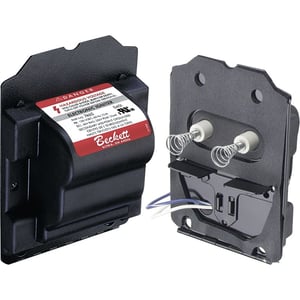Over the past several years, the number of appliances that use electronic igniters has continued to increase thanks to all the benefits these devices provide. In fact, electronic igniters are a critical component of many modern heating systems because they provide more reliable and efficient automatic comfort than the transformers of the past. But what are the features of modern electronic igniters that allow them to provide these advantages, and what vocabulary do you need to know in order to ensure that they're properly maintained and serviced? In this post, we'll discuss the most prominent and beneficial electronic igniter features and terms that you need to know in order to understand their function in the heating system.
Features of Electronic Igniters
Today's electronic igniters:
- mount on a burner housing baseplate similar to that of a transformer.
- are smaller (1/4 to 1/2 the size) and weigh less than a transformer (1lb. compared to 8lb.).
- have oil ignition characteristics similar to that of a transformer.
- offer improved performance with cold oil or delayed spark conditions.
- have output currents and peak voltages that can be up to double that of iron core transformers.
- produce a spark intensity that can be less sensitive to line voltage fluctuations.
- are epoxy sealed for moisture resistance and have oil-resistant, non-rusting plastic enclosures. Epoxy will not shrink and crack like a tar filled transformer, leading to premature failure.
- consume 50 to 75% less power than transformers.
 |
| Click here to learn more about the PowerLight Electronic Oil Igniter from Beckett. |
Igniter Terms and Definitions
CONSTANT DUTY means that the ignitor is designed to be able to stay on continuously. Constant duty ignitors therefore can be used with controls that operate the ignitor with either intermittent or interrupted duty ignition. Most ignitors, unless labeled otherwise, are rated for constant duty.
INTERMITTENT DUTY IGNITION is defined by Underwriters Laboratory (UL) as “ignition by an energy source that is continuously maintained throughout the time the burner is firing.” (UL 296, Paragraph 4.22). In other words, the ignitor is on the whole time the burner is firing.
INTERRUPTED DUTY IGNITION is defined by Underwriters Laboratory (UL) as “an ignition system that is energized each time the main burner is to be fired and de-energized at the end of a timed trial for ignition period or after the main flame is proven to be established.” (UL 296, Paragraph 4.21). In other words, the ignitor comes on to light the flame, and then after the flame is established, the ignitor is turned off and the flame keeps burning.
PEAK VOLTAGE is the maximum voltage reached as a voltage signal alternates positive and negative polarity (see Figures 2 and 3 below).
RMS (“Root-Mean-Squared”) is a time-weighted average of the voltage or current signal. If a current or voltage is sinusoidal, it has a peak value equal to 1.4 times the RMS value.
SINUSOIDAL voltages alternate positive and negative polarity very smoothly and in a continuous “S” shape (see Figure 2 below).
SOLID STATE means that the electronic unit includes semiconductor components, such as diodes, LED’s, triacs, microprocessors, and other transistors.
HERTZ (abbreviated Hz) is a unit of frequency. Line voltage alternates at 60 Hz, or 60 cycles per second.


